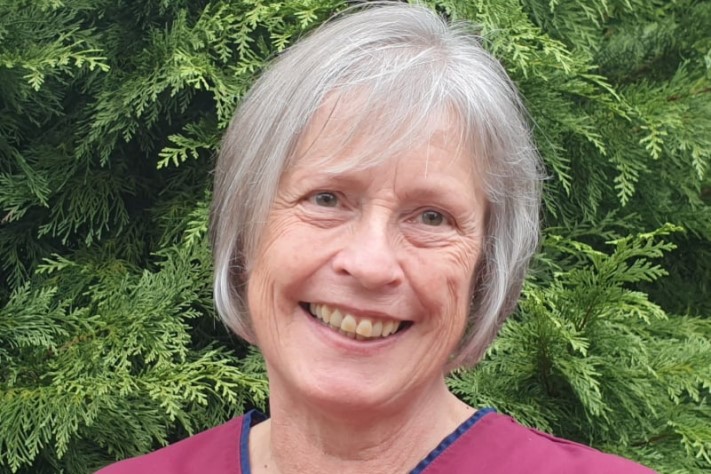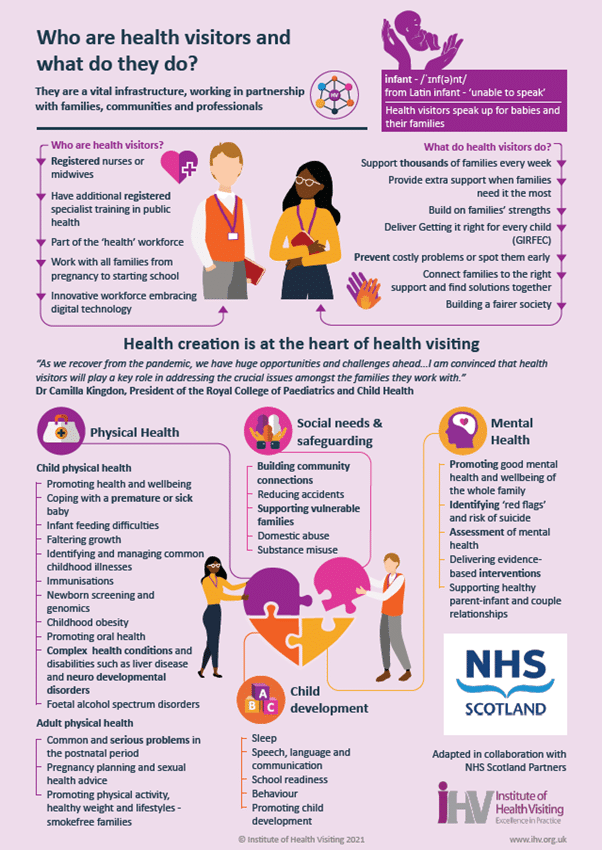20th May 2022
We are delighted to share this Voices blog by Joan Rutherford, Community Clinical Nurse Manager at NHS Borders Primary and Community Services, on adapting the iHV infographic ‘Who are health visitors and what do they do?’ to support Scottish health visiting practice and enable Scottish health visitors to articulate the complexity of their role to families and professionals.

Joan Rutherford, Community Clinical Nurse Manager at NHS Borders Primary and Community Services
One of the biggest challenges that the health visiting (HV) profession faces is that people don’t know who health visitors are and what they do. In the lead up to the autumn Spending Review submission in England last year, the Institute of Health Visiting (iHV) created an infographic[i] to help explain the role of the health visitor. The infographic sets out the breadth of the health visitor’s role, providing a vital infrastructure of support for babies, children, and families.
In September 2021, when I was chair of the Scottish health visitor lead’s network, I was invited by iHV to present at the iHV leadership conference in December 2021 about health visiting in Scotland. I was amazed by the level of interest and enthusiasm from the delegates about the Scottish model and I answered lots of questions on the model during and after the session.
As I prepared for the conference, I became more aware of the political and professional influence of the iHV and the amazing array of resources available to practitioners including the infographic ‘Who are health visitors and what do they do?’ It occurred to me that I must have accumulated many hours during my health visiting career countering assertions that the role starts and stops at ‘weighing babies’.
The infographic was discussed at the Scottish health visitor leads network and, thereafter, representatives met with the iHV to make some adaptions to align with the Scottish context to enable Scottish HVs to articulate the complexity of their role to families and professionals.
In particular, it was important to reflect Scotland’s child health policy in the Scottish version of the infographic. To achieve this, the references to England’s policy were removed and the resource was adapted to include ‘Getting it right for every child’ (GIRFEC), which is the overarching policy framework for children’s services in Scotland. The NHS Scotland logo was also added, alongside a few other minor changes to align with the relationship-based context of the Universal Health Visiting Pathway (UVHP).
The Scottish Health Visiting Model:
To support and maximise the role and impact of health visitors within early years, the Scottish Government invested £40 million to recruit and train an additional 500 whole time equivalent (WTE) health visitors to deliver the Universal Health Visiting Pathway (UHVP) by Jan 2020 to enable the following:
- A structured home visiting service and refocused role from pre-birth to school entry with a minimum of eleven Health Visiting contacts from the 32-36 weeks of pregnancy until the child enters school.
- A comprehensive and standardised approach to the delivery of health and wellbeing information and support.
- Adaptation of the relevant postgraduate education Specialist Community Public Health Nursing (SCPHN) to support the refocused role.
- Additional training of existing health visitors to support the new educational components.
A longitudinal study of the Universal Health Visiting Pathway[ii] has been commissioned by Scottish Government. Phase 1 was published in 2021 and findings include:
- All Health Boards in Scotland are now delivering the UHVP.
- Health visitors feel confident in their knowledge and skills to deliver the UHVP.
- The frequency of visits enhanced the building of positive and trusting relationships.
- Almost all health visitors felt that the UHVP facilitates the early identification of strengths and concerns of children and parents.
- A significant proportion of health visitors felt the UHVP offered the opportunity to discuss and support parents on various topics, including child wellbeing, safety, and attachment.
- 89% of parents stated they knew a great deal or a fair amount about the impact on children of parents smoking, drinking alcohol, or using drugs.
- Parents living in the most deprived areas of Scotland are most likely to report having received a great deal or a fair amount of information from their health visitor.
It is incredible to hear about the positive impact that the UHVP is having on babies, children, and families in Scotland. It is also fantastic to hear the positivity of health visitors about the UHVP.
Georgina Mayes Policy and Quality Lead says:
“Scotland is delivering a health visiting service that England aspires to have. Health visiting in England is facing the brunt of disinvestment right now but we must hold onto hope. Even the strongest tides, when the time is right, will turn[iii] and we hold onto the hope that this tide will turn, just like it did for Scotland…”
To find out more about the Scottish HV model, read: ‘Universal Health Visiting Pathway evaluation – phase 1: main report – primary research with health visitors and parents and case note review’ which contains the key primary research findings from the evaluation of Scotland’s programme to strengthen their health visiting service:
Joan Rutherford, Community Clinical Nurse Manager at NHS Borders Primary and Community Services
References
- [i] iHV (2021) Infographic – Who are Health visitors and what do they do?
- [ii] Scottish Government (2021) Universal Health Visiting Pathway evaluation – phase 1: main report – primary research with health visitors and parents and case note review
- [iii] OHA (2021) Turning the tide. A ten year healthy weight strategy: Turning-the-Tide-A-10-year-Healthy-Weight-Strategy.pdf (obesityhealthalliance.org.uk)







